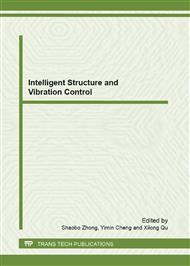[1]
Hoek, E. and Brown, E.T. Underground Excavations in Rock. London: The Institution of Ming and Metallurgy, (1980).
Google Scholar
[2]
Lajtai, E.Z. and Lajtai, V.N. The collapse of cavities. Int. J. Rock, Min. Sci. & Geomech. Abst., 12(1) (1975) 81-86.
DOI: 10.1016/0148-9062(75)90001-7
Google Scholar
[3]
Carter, B.J. and Lajtai, E.Z. Stress and time-dependent fracture around cavities in physical models of Potash salt rock. In Hudson J. A. ed. Proc. ISRM Symposium: Eurock'92, Chester, Rock characterization, Imperial College, London, (1992) 269-274.
Google Scholar
[4]
Martin, C.D. Seventeenth Canadian geotechnical colloquium: the effect of cohesion loss and stress path on brittle rock strength. Can. Geotech. J., 34(5) (1997) 159-168.
DOI: 10.1139/t97-030
Google Scholar
[5]
Fu, Y.F., Huang, M.L., Ren, F.Y. and Tang, C.A. Numerical analysis of crack evolution around borehole in rock sample subjected to confining pressures. Chinese Journal of Rock Mechanics and Engineering, 19(5) (2000) 577-583.
Google Scholar
[6]
Zhang H.Q., Zhao D.S., et al. Numerical Study on Fracture in Rock Surrounding a Circular Tunnel under Different Confining Pressure, In: Ohnishi Y, Aoki K, eds. Contribution of Rock Mechanics to the New Century. Rotterdam: Millpress, (2004).
Google Scholar
[7]
Tang, C.A. Numerical simulation on progressive failure leading to collapse and associated seismicity. Int. J. Rock Mech. and Min. Sci. 34(1997) 249-261.
Google Scholar
[8]
Tang, C.A., Liu, H, Lee, PKK, Tsui, Y. and Tham L.G. Numerical studies of the influence of microstructure on rock failure in unaxial compression-part I: effects of heterogeneity. Int. J. Rock Mech. Min. Sci., 37(2000) 555-569.
DOI: 10.1016/s1365-1609(99)00121-5
Google Scholar
[9]
Hudson, J.A. and Fairhurst C. Tensile strength, Weibull's theory and a general statistical approach to rock failure. The proceedings of the Civil Engineering Materials Conference, Southampton (1969) 901-904.
Google Scholar
[10]
Brady, B.H.G. & Brown, E.T. Rock Mechanics for Underground Mining, Second Edition. London: Chapama & Hall Press, (1993).
Google Scholar
[11]
КУРЛЕНЯ М. В., ОПАРИН В.Н. Проблемы нелинейной геомеханики. Ч. I. ФТПРПИ, 3(1999) 12-23.
Google Scholar
[12]
Li S. C., Wang H.P., Qian Q.H., et al. In-situ monitoring research on zonal disintegration of surrounding rock mass in deep mine roadways. Chinese Journal of Rock Mechanics and Engineering, 27(8)(2008) 1545-1553.
Google Scholar
[13]
Xu H.F., Qian Q.H., Wang F.J., et al. Application of electric resistivity method to zonal disintegration exploration of deep roadway. Chinese Journal of Rock Mechanics and Engineering, 28(1)(2009) 111-119.
Google Scholar


